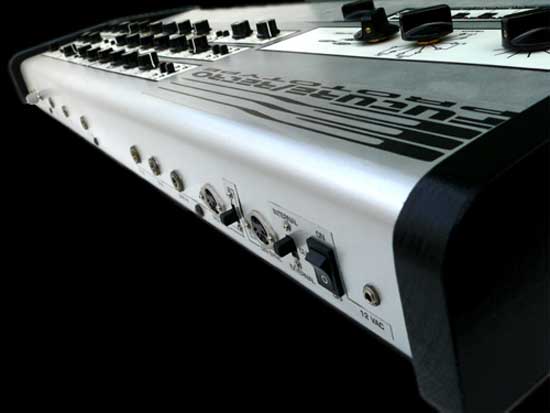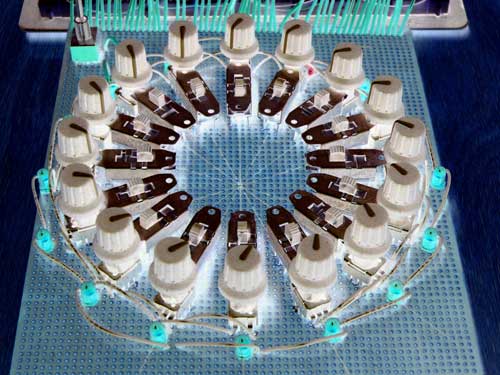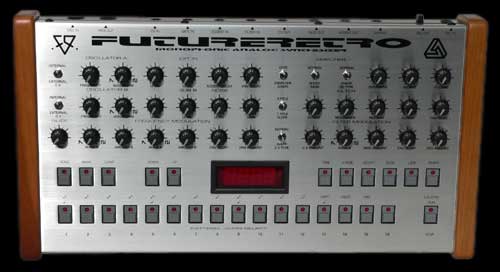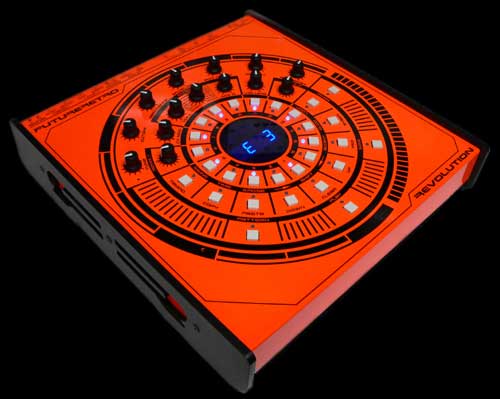
Future Retro’s Jered Flickinger is celebrating 10 successful years in business with a gear porn retrospective of rare FR prototypes.

Here’s an image of the Abstrak sequencer, a prototype of a new type of analog sequencer built using discrete logic components. The rhythm switches could define if notes were off, on, or sustained, while the knobs set the pitch for each step. This model also had a true analog swing function.
Flickinger also offers a bit of biographical background on himself and how he turned Salina, Kansas into a hub of hardcore acid-style synth action….
As a child I grew up playing with the tools and machinery on the assembly line of my fathers company, which designed and manufactured musical tuners, guitar and bass amplifiers, PA systems, and more during the 70’s and 80’s. It was like a jungle gym of technology, innovation and craftsmanship. At the age of 7 I would attend my first NAMM show, as my father’s company displayed their products to the music industry. Interesting however is that looking through their old photos of that show, I find pictures of the TB-303 and TR-606 on display for the first time. Why they even took those pictures I don’t know, they weren’t into synthesizers at all. And me… I wanted to play the drums. Who knew that 15 years later I would end up making instruments similar to those.
At 14 I began DJing and playing electronic musical instruments. I remember my first instruments were an Ensoniq SQ-80 synth, Kawai R-50e drum machine, and a Boss SE-50 processor. It wasn’t much, but having less kept me creative and I learned them inside and out, as I made my attempt at creating “industrial” type music. In highschool I was in a cover band for a short while where we played songs by, NIN, Ministry, Janes Addiction, The Cure, New Order, The Shamen and more. It was a lot of fun, but lets face it, getting all the members together to practice rarely happened. So I focused more on the electronic side of music, producing dance music as my DJ instincts took over, doing music for a few local hip-hop acts, mixing dance music for choreographers, doing live mixes on the radio and creating radio commercials, promoting and DJing raves, opening a dance club for teens, and finally landing several full time residencies as a DJ in the club scene all by the age of 19. While working in the clubs I would also work in record stores, and music instrument shops, where I started doing repairs for others and modifications to my own synthesizers. As I learned them inside and out, I thought, I can do this… I want to make my own synthesizer and I want it to have this feature and that, and be able to sound like all my favorite groups.
And so I spent just over a year creating the circuits which would later be known as the 777 synthesizer. Although not without a few setbacks. I remember having the first prototype laid out all over my desk, bread boarded up with wires going everywhere, and everything was working as I make a few last tweaks here and there to the circuits… until one day I got caught up in those wires as I walked away from my desk bringing the whole thing crashing down on the floor. It took weeks to bring it back to life. Once I had it working again the next step was to make the first physical prototype. So I molded my own chassis out of fiberglass, hand made all its stickers and legends, fabricated some wood ends, and hand wired all the circuits onto perf-boards which I could mount inside the unit. The result was a lot of work, although I remember thinking… hmm… I could make a couple of these a year. So I took that prototype around to local concerts with me, trying to get musicians opinions of what I had created. It was then that I met up with Dennis of Skylab2000, and he played the prototype and gave me his feedback… I like this, why did you do that, can you do this instead? So I took it back to the drawing board, convinced my father to write the code for our sequencer, as we spent the next year implementing some of his ideas and our own, and also thinking how can I make more than just a couple of these a year?
At 14 I began DJing and playing electronic musical instruments. I remember my first instruments were an Ensoniq SQ-80 synth, Kawai R-50e drum machine, and a Boss SE-50 processor. It wasn’t much, but having less kept me creative and I learned them inside and out, as I made my attempt at creating “industrial” type music. In highschool I was in a cover band for a short while where we played songs by, NIN, Ministry, Janes Addiction, The Cure, New Order, The Shamen and more. It was a lot of fun, but lets face it, getting all the members together to practice rarely happened. So I focused more on the electronic side of music, producing dance music as my DJ instincts took over, doing music for a few local hip-hop acts, mixing dance music for choreographers, doing live mixes on the radio and creating radio commercials, promoting and DJing raves, opening a dance club for teens, and finally landing several full time residencies as a DJ in the club scene all by the age of 19. While working in the clubs I would also work in record stores, and music instrument shops, where I started doing repairs for others and modifications to my own synthesizers. As I learned them inside and out, I thought, I can do this… I want to make my own synthesizer and I want it to have this feature and that, and be able to sound like all my favorite groups.
And so I spent just over a year creating the circuits which would later be known as the 777 synthesizer. Although not without a few setbacks. I remember having the first prototype laid out all over my desk, bread boarded up with wires going everywhere, and everything was working as I make a few last tweaks here and there to the circuits… until one day I got caught up in those wires as I walked away from my desk bringing the whole thing crashing down on the floor. It took weeks to bring it back to life. Once I had it working again the next step was to make the first physical prototype. So I molded my own chassis out of fiberglass, hand made all its stickers and legends, fabricated some wood ends, and hand wired all the circuits onto perf-boards which I could mount inside the unit. The result was a lot of work, although I remember thinking… hmm… I could make a couple of these a year. So I took that prototype around to local concerts with me, trying to get musicians opinions of what I had created. It was then that I met up with Dennis of Skylab2000, and he played the prototype and gave me his feedback… I like this, why did you do that, can you do this instead? So I took it back to the drawing board, convinced my father to write the code for our sequencer, as we spent the next year implementing some of his ideas and our own, and also thinking how can I make more than just a couple of these a year?
Get the full story at the Future Retro site. You can also find out more about Flickinger and Future Retro in Synthtopia’s Jered Flickinger interview.
Here’s a few more images – check them all out at FR:

A rare custom 777 with a brushed silver face.

The UV orange SE Revolution units shown above were sold exclusively through Analogue Addiction in the UK.
I’ve got a Future Retro Mobius and a FR 777, and it’s obvious from these that one of secrets to Future Retro’s success is making unique kick-ass gear. Congrats to Jered on 10 years of business!
